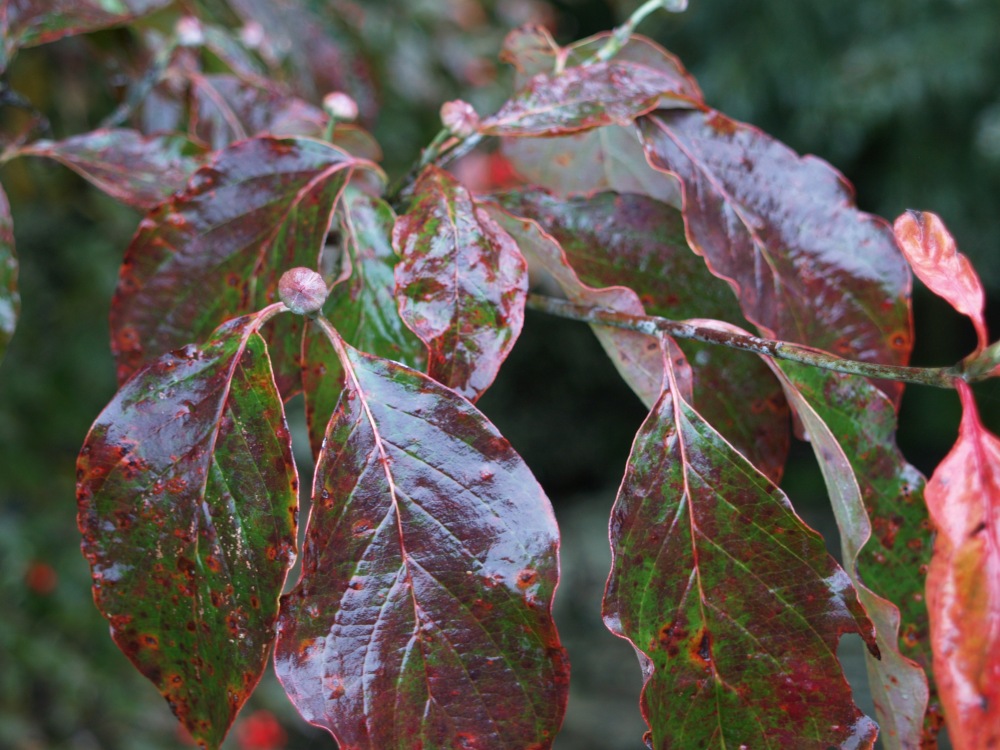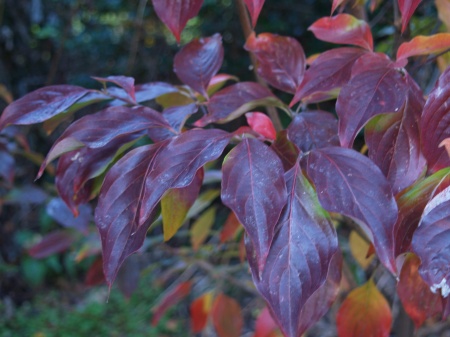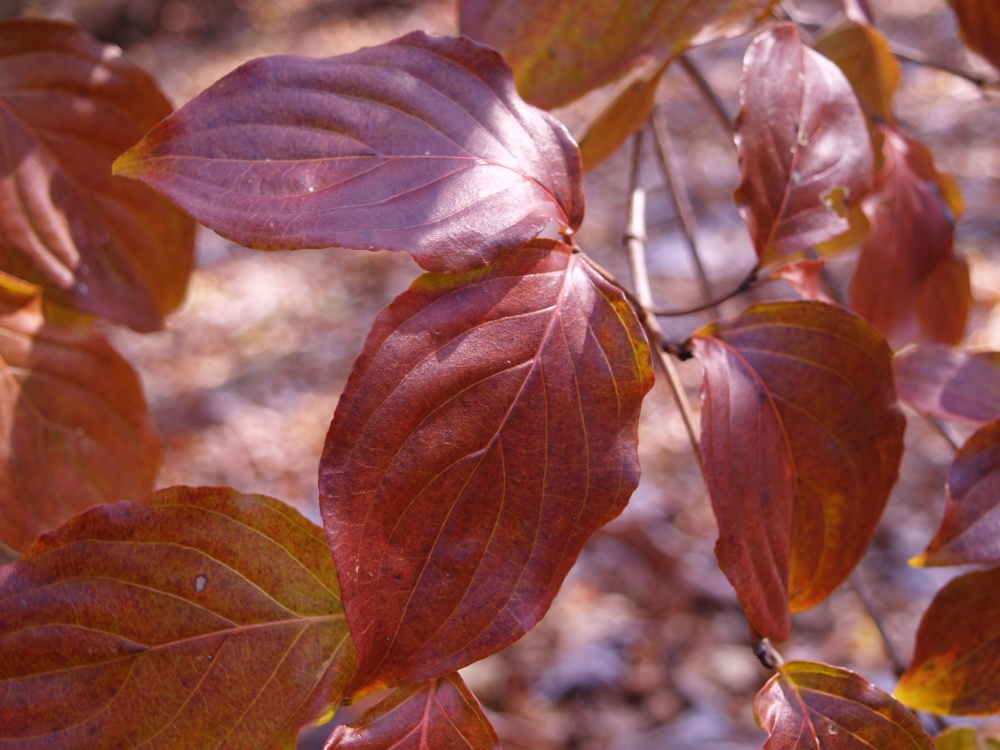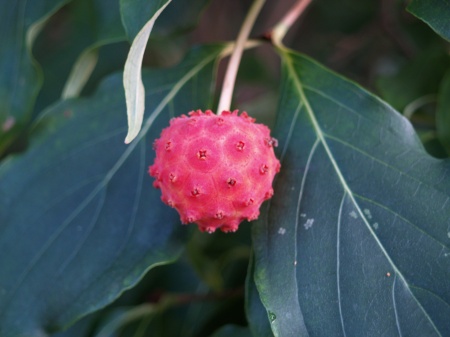From a distance, the rich crimson foliage of the native dogwood (Cornus florida, below) is quite marvelous in early November. Dogwoods typically turn early, and the foliage persists at least a week or two into November. But, on closer inspection the leaves are curled and spotted, a consequence of high humidity and summer rains in this northwestern Virginia garden. Fortunately, the culprit is not the dreaded dogwood anthracnose (Discula destructiva), but a more benign leaf spot that is more commonplace and less disfiguring. Rarely a summer passes without at least some spotting, and occasionally it is severe and joined by varying amounts of powdery mildew. (The variegated leaf ‘Cherokee Sunset’ in the garden is rarely without both spots and mildew in any summer, and thus I don’t recommend this tree despite its extraordinary foliage and red flowers. Sunset’s leaves dropped weeks ago.)
This all sounds horrid, but in fact it is not. I hesitate to broach the subject for fear that some might be cautioned against planting the native dogwood, but despite these troubles the dogwood in the front garden plugs along nicely. Branch cankers are more liking to cause the tree’s eventual demise, but this dogwood has lived a long life already (nearly twenty five years), and I’m confident its end is not imminent. Other native dogwoods in the garden have more minor problems to varying degrees, but still I am satisfied enough to plant another tomorrow, or several if there was more space.
I suspect there in not an experienced gardener who has not suffered the loss of favored plants, many in their relative infancy, but others that have survived for decades only to come to their tragic end. There are nearly as many causes for an old tree to die as there are old trees, and after a brief moment for mourning the loss should be considered an opportunity to start again. For this dogwood, it’s a wonder that it manages to survive these various maladies, yet it continues to flower and berry as if it has no problems at all.
In many years, the dogwood’s red berries persist into early December, but this year they were quickly consumed by birds a month ago. Some gardeners might figure that this portends a cold or snowy winter, but instead it seems to me that there are probably more and hungrier birds, and there’s no correlation to the coming winter’s weather at all. It does also seem a bit odd that deer have stripped the foliage from many of the mophead hydrangeas, which has not happened before in this garden. I have read that the naturally occurring aluminum that turns the large flowers blue is toxic, and so it discourages deer from eating blue flowered hydrangeas. I can only figure that as the shrubs have started into dormancy there is a change in the chemistry of the foliage, but here I’m delving into matters that are far over my head.
But, back to dogwoods. Unquestionably, the native dogwood is an exceptional tree. Few trees can compare to the delightful spring blooms, autumn foliage color, and abundant red berries, but there are other remarkable dogwoods to consider. To my thinking, none measure quite to the native’s standard, but hybrid and Chinese dogwoods are considerably more disease resistant, and these are lovely trees by any standard.
The gardener needs only to gaze at the deep red and unblemished foliage of the hybrid ‘Celestial Shadow’ (Cornus x ‘Celestial Shadow’, above) in early November to appreciate that the tree’s seasonal interest extends far beyond its bloom and variegated foliage. Hybrids ‘Venus’ and ‘Stellar Pink’ have proven to flower and grow exceptionally in my garden, and their autumn foliage display is on par with the native dogwoods’. None of the hybrids has displayed the strawberry-like fruit that is inherited from their Chinese dogwood lineage, but if this comes in time it will be a bonus.
The Chinese dogwoods (Cornus kousa) seem more variable in their autumn foliage colors from one year to the next. Just as our native dogwood, the leaves persist long into November, though they begin to color much later. The upright growing, vigorous ‘Galilean’ dogwood (Cornus kousa ‘Galzam’, above) and the pink flowered ‘Satomi’ (Cornus kousa ‘Satomi’, below) have recently started to turn, but the color will deepen over the next week. Some years the foliage color is unremarkable, particularly where the dogwoods are planted in part shade.
Occasionally, the leaves of ‘Satomi’ are mottled in red and orange, but this year both ‘Galilean’ and ‘Satomi’ are only red. The foliage of the green and white variegated Chinese dogwoods, ‘Wolf Eyes’ and ‘Samaritan’, only fades to tan before falling, so they are of no consequence in the autumn garden (though they are splendid through spring and summer). ‘Galilean’ is planted in the most sun, and it is the only one of the Chinese dogwoods to bear the strawberry-like fruits in mid summer. The fruits are quickly eaten by birds, persisting for a shorter time even than the native dogwood’s.
Dogwoods are wonderfull trees! They are so common here in Piedmont North Carolina.
When we lived in Fairfax Va, it was a toss up which was more beautiful in spring..the azaleas or dogwoods. Our neighborhood was blanketed in both, and the beauty was truly breathtaking!
For me, the blooms of dogwoods and redbuds are the sure signs that spring has finally arrived. Earlier flowers might be followed by snow (as they were this year), but once redbuds and dogwoods flower spring is really here to stay. The lesser popularity of hybrid and Chinese dogwoods is because they flower later, and after they leaf so that the blooms are not as prominent.
Definitely appreciate the all-about dogwoods post as I’ve been considering planting one in my garden for some time. However, my garden is relatively low-profile with no plant/bush over 4/5 ft in height. Is there a dogwood variety that would fit this profile, e.g., a minature? If not, would a “normal” dogwood take to pruning my desired height/ shape? Assuming it’s too late this year, when would I plant the dogwood?
Totally unrelated: When should I cut back hostas and mums?
Thanks! Bill
Sent from my Verizon SmartCell
I’ve seen true dwarf dogwoods that will stay well under ten feet tall, but the market for these is extremely limited and I doubt that they will have the desirable characteristics that make dogwoods so popular. The smallest of the dogwoods in my garden is the wide spreading, variegated leaf Chinese dogwood ‘Wolf Eyes’. It is only about six or seven feet all after seven or eight years, but it is at least as wide. Dogwoods do not take well to pruning, and I think it’s impractical to maintain a tree that wants to be twenty feet tall to less than half that height. Eventually, the tree will get away from you, so you’re much better off choosing a tree that you will not have to keep pruned.
Hostas practically disappear after a freeze, so there is no problem with cutting them back at any time. Hardy mums are very tough, so they can be pruned at any time.
Bought my mums at home depot clearance last week. The tag simply calls them Annual Mums. Are these hardy and will come back next year, or did I just get a few weeks of viewing pleasure at 50% off?
The mums that most garden centers sell are cold hardy, but there are some exceptions, so they’re safest saying that the plants are annuals. Mums take a bit of care to keep pruned and pinched to promote compact plants, but most are quite tough so you’d have to try hard to kill them.